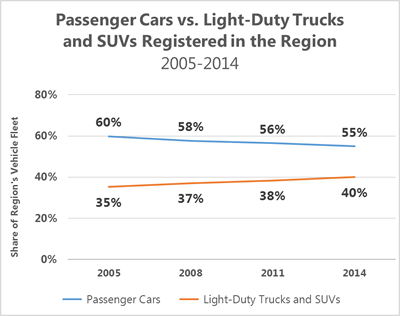Every three years the Transportation Planning Board carries out a regional vehicle "census" to determine the year, make, and model of nearly every car and truck registered in the Washington region. The analysis yields important information about the changing age and make-up of the region's vehicle fleet that helps the TPB refine its forecasts of future vehicle-related emissions of key air pollutants and greenhouse gases.
One of the most important findings of the latest vehicle census, carried out in 2014, was that the average age of the region's vehicle fleet increased since the last survey in 2011. That means that vehicle owners on average were waiting longer to replace older cars and trucks with newer ones. According to the vehicle census, the average age of the fleet in 2014 was 9.5 years, about 0.4 years older than in 2011.

The aging is important for the TPB to consider because it means that new federal fuel efficiency and other vehicle emission standards may take longer to positively impact the region's air quality than previously thought. Such measures only work when consumers buy vehicles that meet the new standards and drive those vehicles instead of older, less efficient models.
The fleet aging that occurred between 2011 and 2014 is part of a longer-term trend observed by the TPB since at least 2005. In that time, the average age of the region's vehicle fleet increased by 1.65 years. The fastest rate of increase came between 2008 and 2011, when the national economic downturn likely pushed more individuals, families, and businesses to further delay purchases of new vehicles.
More: Economic Downturn Slows Anticipated Growth in Driving Through 2020, But Pushes Up Forecasts of Vehicle-Related Emissions
Another key finding of the TPB's 2014 vehicle census which might also slow future air quality gains is that light-duty trucks and sport-utility vehicles (SUVs) now make up 40% of all the cars and trucks in the region, more than ever before. This has implications for the region's air quality because light-duty trucks and SUVs typically have lower fuel efficiency and higher overall emissions than passenger cars.

Finally, one trend that's having a positive impact on vehicle-related emissions and air quality is growth in registrations of hybrid-electric and all-electric vehicles. The 2014 vehicle census found more than 100,000 hybrid-electric vehicles and nearly 1,500 all-electric vehicles registered to area drivers. These vehicles represent a small but growing share of the more than 3.9 million cars and trucks registered in the region as of the 2014 vehicle census.
More: See the full summary of results from the TPB's 2014 vehicle "census"
The TPB is now using the results of the latest vehicle census as one of several important inputs into its forecasts of future vehicle-related emissions under this year's proposed update of the region's Constrained Long-Range Transportation Plan (CLRP). The forecasts are required under federal law to show that future emissions remain below regional limits approved by the U.S. Environmental Protection Agency. The new information on the age and make-up of the region's vehicle fleet will help the TPB make predictions that better reflect changing realities in the region.
The results of the air quality forecasts will be available in September, at which point TPB stakeholders and the general public can review and comment on the results before the TPB considers the 2015 CLRP update for final adoption in October.
Related TPB Weekly Reports:
As Ozone Season Gets Underway, Air Quality Analysis of 2015 CLRP Update Kicks Off
Slowdown in Vehicle Replacement Could Negatively Impact Region's Air Quality